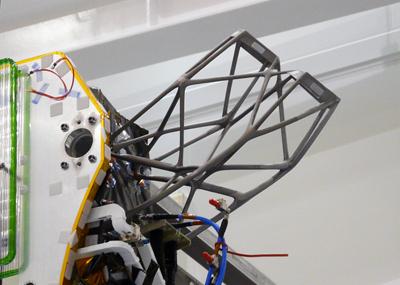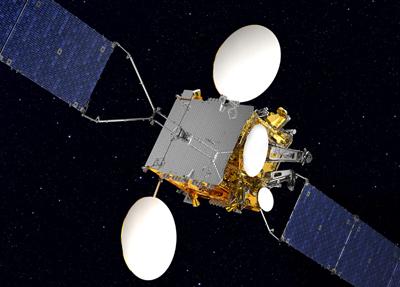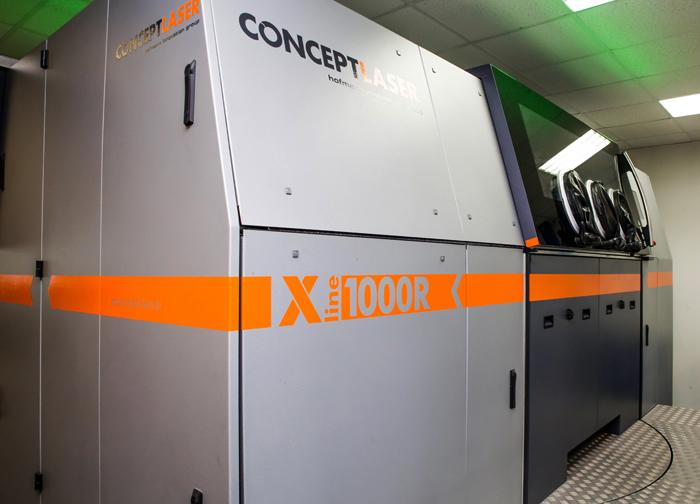Thales Alenia Space Looks to Space with Large Qualified 3D Printed Satellite Components and a New Collaboration
 One thing that’s exciting about working in an industry as new and fast-growing as 3D printing is that we’re constantly seeing firsts. First 3D printed glasses, first 3D printed heel bone, first industrial silicone 3D printer – nearly every day there’s a new thing that’s never been seen before, or there’s a record being set somewhere. Right now, it’s an industry of superlatives – biggest ever, fastest ever, most successful ever.
One thing that’s exciting about working in an industry as new and fast-growing as 3D printing is that we’re constantly seeing firsts. First 3D printed glasses, first 3D printed heel bone, first industrial silicone 3D printer – nearly every day there’s a new thing that’s never been seen before, or there’s a record being set somewhere. Right now, it’s an industry of superlatives – biggest ever, fastest ever, most successful ever.
Holding one of the “biggest ever” titles is the team of Thales Alenia Space (TAS) and Poly-Shape, which broke a very specific record by creating the largest-ever qualified parts to be 3D printed in Europe using powder-bed metal additive manufacturing for use in orbit. Like I said, very specific – but no less impressive. The partnership was begun last fall when the two companies agreed to manufacture support structures for South Korea’s newest communication satellites, Koreasat-5A and Koreasat-7.
The antenna supports, which were printed by TAS using a Concept Laser X line 1000R 3D printer supplied by service bureau Poly-Shape, are basic structures that allow the satellites to communicate with the ground base, but the key of the 3D printed parts is their light weight. Although their dimensions are 450 x 205 x 390 mm, they weigh only 1.5 kg, significantly less than the same components manufactured by other methods.
“The typical cost of putting 1 kg of material into orbit is around €20,000, so every gram really does count,” said Florence Montredon, Head of Additive Manufacturing for Thales Alenia Space. “The starting weight of the two new satellites is around 3,500 kilograms…The effects were huge: a 22% weight saving for the bionic AM structure compared to a conventionally-manufactured structure. Not forgetting the reduction in costs of around 30% with the finished part also being available very much earlier.”
 TAS used a AISi7Mg alloy to attain the components’ light weight without sacrificing strength, rigidity or corrosion resistance. The supports also ended up with an impressively low porosity of less than 1%, as demonstrated in the component validation process. Additional tests of tensile and shear strengths, along with fatigue resistance, also yielded positive results, according to TAS and Poly-Shape.
TAS used a AISi7Mg alloy to attain the components’ light weight without sacrificing strength, rigidity or corrosion resistance. The supports also ended up with an impressively low porosity of less than 1%, as demonstrated in the component validation process. Additional tests of tensile and shear strengths, along with fatigue resistance, also yielded positive results, according to TAS and Poly-Shape.
By using additive manufacturing, the components were able to be produced in one piece rather than nine, as with traditional manufacturing methods. While the large size of the supports was a challenge, the massive, 630 x 400 x 500 mm build envelope of the X line 1000R, the largest of Poly-Shape’s 28 printers, was more than up to the task.
“It is clear that we have identified AM as a good prospect for further projects,” said Montredon. “In the future, we would also like to incorporate thermal control technology or radio functions directly on or within the 3D structures. So functional integration is the next task. This is also a logical consequence of the potential offered by AM.”
The supports, which each took six days to print, will be implemented on the two satellites, which are scheduled to go into orbit in early 2017. By that time, will they still hold the title of largest-ever parts to be 3D printed in Europe using powder-bed metal additive manufacturing for use in orbit? Who knows – maybe TAS and Poly-Shape will have broken their own record by then.
Furthering its opportunities in space, Thales Alenia Space has also announced that they have signed a contract with Norsk Titanium toward the collaboration of development, testing, and production of titanium test components for use in space. Announced today, July 13th, the collaboration is set to create an initial qualification lot this year for titanium components supporting a joint test and acceptance program for spaceflight. Full production is then set to commence in 2017, as Norsk Titanium will then embark on full rate production of the Thales Alenia Space components.
“We are thrilled to partner with Thales Alenia Space and to extend the benefits of Rapid Plasma Deposition from earth-based commercial airliners all the way into outer space. The space frontier is a great market for our titanium RPD parts since they are extremely fast to build, incredibly light, and can be used in applications of significant structural importance,” said Norsk Titanium CEO Warren M. Boley Jr.
While full details on the engineering of the Rapid Plasma Deposition (RPD) parts for the qualification order have not been disclosed, each component produced using the RPD process is set to improve upon traditional forging processes. Each component has a three kilogram final mass, and the change to RPD is said to reduce the current part buy-to-fly ratio by half and cut the lead-time by half a year. Discuss further in the TAS Largest 3D Prints forum over at 3DPB.com.
Subscribe to Our Email Newsletter
Stay up-to-date on all the latest news from the 3D printing industry and receive information and offers from third party vendors.
You May Also Like
3D Printed Heat Spreader Could Improve Efficiency of Electronics
The low-hanging fruit for decarbonization has long been improving the efficiency of existing systems, hence the justification for LED lights and ENERGY STAR certified appliances. While such minor moves are...
3D Printing News Unpeeled: Marine Gearboxes, 3D Printed Motors and $1.7 Million in Seed Funding
UK based Equipmake just released their Ampere-220 e-axle system. The system, which is meant for high performance electric cars, was similar to one released on the Ariel HIPERCAR. It has...
CEAD Unveils 36-Meter-Long 3D Printer for Abu Dhabi’s Al Seer Marine
CEAD, a Dutch original equipment manufacturer dedicated to large-format 3D printers, has unveiled what it claims to be the world’s largest robotic arm-based 3D printer. At 36 meters long and...
3D Printed Biocomposites Could Help Reduce Marine Plastic Pollution
Concerns about the impact of plastic litter and microplastics in the oceans are at the forefront of environmental study. For decades, the marine environment has suffered from the degradation of...





































